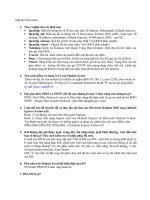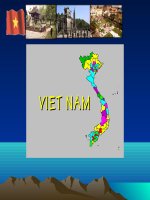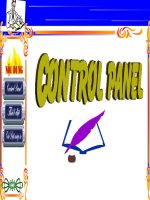vietnam poison control center
Bạn đang xem bản rút gọn của tài liệu. Xem và tải ngay bản đầy đủ của tài liệu tại đây (11.12 MB, 56 trang )
1
Vietnam Poison Control Center
An introduction
2
Vietnam in brief
A developing country approximately 330,900Km
2
.
Population over 80 million, with 80% farmers.
Vietnam: an agricultural country.
Blooming of economy from 1991.
Developing tourism.
Health care system: 61 provinces with only PCC
placed in Ha Noi (Bach Mai university hospital).
Other poisoned patients
→
EMs & ICUs at local
hospitals.
3
Toxicologic epidemiology
general condition
Increasing risks of toxical industrial chemicals, agricultural chemicals,
imported drugs, venomous animals, alcohol, drugs abuse, food
poisonings.
Over 25 years since the last war, warfare toxic agents: dioxin, CS
1996 1997 1998 1999 2000
Poisoned patients 9524 10372 8110 8339 8916
Deaths 273 335 305 252 244
% Mortality 2.86% 3.23%
3.76
%
3.02% 2.74%
Survey in 48 local hospitals
4
Toxicologic
epidemiology
general condition
24.81%
17.76%
17.67%
12.16%
8.12%
4.77%
2.64%
1.47%
10.60%
0.00%
5.00%
10.00%
15.00%
20.00%
25.00%
Pesticides Sedative-
drugs
Food
poisoning
Rodenticides Venemous
animal
Opiates alcohol Chemical Other
reasons
1
st
:pesticides (OPs, carbamat, organochloride,
trifluoroacetamide, Zn phosphide, thallium;
new insecticides-nereistoxin , herbicide)
2
nd
:sedatives and drugs abuse or overdose,
opiates and alcohol
3
rd
:venomous animals and plants: snakebite,
puffer fish, bee stings, toad venom, poisonous
plants, mushroom
5
Toxicologic
Epidemiology
reported
cases.(%of
total)
Numeralmortality
(Mortality,
expressedin%of
reported)
1.Pesticides
24.81% 6.61%
2.Sedative-drugs
17.76% 0.86%
3.Foodpoisonings
17.67% 0.24%
4.Rodenticides
12.16% 3.5%
5.Venomousanimal
8.12% 3.42%
6.Opiates
4.77%
5.12%
7.Alcohol
2.64% 0.28%
8.Chemicals
1.47% 6.17%
9.Othercauses
10.6% 7.48%
Total
100% 3.26%
Survey in 48
local hospitals
6
Toxicology
epidemiology
Pesticide poisoning
Annual importing ~ 30.000 tons of raw
materials and pesticides ~120 millions USD
743 types of permitted commercial
insecticides, formulated of 171different
activated elements
organophosphate in the North and Paraquat in
the South.
Illegally Imported rodenticides: exessive use,
suicide, dangerous misuse in children (7% of
acute poisoning)
7
poison control center
Bach Mai Hospital
Establishment and development:
1998, Department of clinical toxicology, separated from the
emergency and intensive care department.
17/9/2003: National poison control center.
8
Personels
Number of patient bed: 20
Administration board: Director :Prof. Nguyen Thi Du, Vice
directors: MD. Pham Due, MD. Nguyen Kim Son.
Staffs: 8 doctors: 3 PhD, 3 masters, 1 pharmacologist,1
pharmacist, 1 bachalor of informatics, 21 nurses.
9
Member units:
Clinical
Management of acute and chronic poisoning patients.
Management of prehospital poisoning emergency.
Research, development of new preventive and curative
measures.
Education and training.
10
Member units:
Laboratory
Toxicology analysis.
Study and development of antidotes.
Training of laboratory staffs in the field of toxicology
11
Member units:
Poison information office
Collection, processing and reporting of data and information.
Consultation of poisoning.
Link to
and exchange of information with other PCCs,
related
organizations.
Organization of conferences and workshops.
12
Achievements
Clinical unit: the most developed one
Annual number of poisoned patients addmitted
13
Achievements
Clinical unit: the poisoned-related death (%)
14
Achievements: Clinical unit
Reasons for poisoning
(The year 2004)
Homicide Misuse Suicide Accident Total
7
0,38%
14
0,76%
445
24,12%
1380
74,76%
1846
15
Achievements
Clinical unit: causes of poisoning
(2004)
Causes No of patients
Food poisoning 659
Sedative/hypnotics 327
Drugs of abuse 258
Venoms 228
Pesticide 125
Other medications 87
Household chemicals 49
Toxic plants 42
Analgesic/antipyretics 41
Heavy metals 18
Other causes 12
16
Achievements: Clinical
Characteristics of poisoning
Causes are diverse, complicated and dangerous.
Special agents:
+ Pesticide: organophosphate, carbamate, organochloride,
trifluoroacetate, tetramine (possibly), nereistoxin,
cyanoacetamide and many new chemicals.
+ Metals: Pb, Hg, As, Thallium,
+ Toxic gases: CO, Chlorine,
+ Food poisoning: complicated, not only by microbial
agents
+ Natural toxins: snakebite (viper, cobra, krait), beesting
(severe), pufferfish, many unidentified toxins in plants.
+ Drugs of abuse: heroin, amphetamin, marijuana.
+ Medication: cold preparations, rotundin, barbiturate,
17
Achievements: Laboratory
PCC Refer to
other labs
From local
Hospitals
Total
4841 394 119 6111
Naja
naja
King
cobra
Agkistrodon
rhodostoma
Trimesurus
stejnereri
Negative Total
36 6 3 3 122 170
Application of Snake venom detection kit, 2004
18
Toxicology laboratory
.
19
Achievements: Researches
38 studies at various levels:
All studies are clinical.
- State level: Study in to proposed network of poison
control in Vietnam and the management measures of
mass and acute poisonings in argriculture, industrial
activities and dailly life.
- Ministry level:
+ Development of preparation method for the antidote
B.Mai-ANTIPOIS.
+ Investigation and study in to drugs overdoses
commonly encountered in hospitals.
20
Researches (continued):
1. Titration of pralidoxime doses according to clinical signs and the
doses of atropine in the treatment of acute organophosphate
poisoning.
2. Nereistoxin poisoning.
3. Clinical manifestation and treatment of acute chinese rodenicide
poisoning.
4. Treatment of snakebite (Naja Kaouthia) with antivenom.
5. Combination of charcoal and sorbitol in the treatment of acute
poisoning.
6. Improvement of gastric lavage technique in the treatment of acute
poisoning.
7. Correlation between plasma drug level and clinical features in
phenobarbital poisoning.
8. Clinical and laboratory features and treatment of alcohol withdrawal
syndrome.
And many other studies
21
Achievements:
- Publication:
+ Emergency treatment of Poisoning,
+ Guideline on Rapid Diagnosis and Management of
Acute Poisoning,
+ Handbook of emergency treatment, Emergency and
Intensive Care Medicine.
+ Guideline on Emergency Treatment in 22
nd
Seagame.
+ Training materials for advanced courses.
- Taking Counsel with the Ministry of Health for investigations,
researches and guidance on toxicological prevention and
management.
- Organization of annual workshops and conferences.
22
-
Published researches and books
23
Published researches and books
24
Published researches and books
25
Remaining difficulties
Clinical:
-
Despite of large number of poisoned patients NO
clinical toxicologist has been
trained.
-
Lack of important antidotes.
-
Lack of information on toxicology.
Information:
-
Not yet funded, lack of appropriate equipment.
-
No communication network from national PCC to
local health stations.









